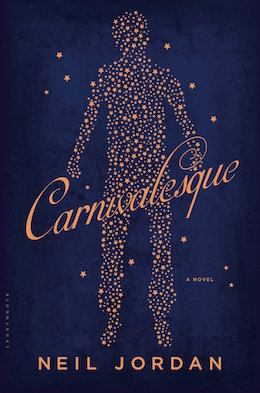Neil Jordan’s Carnivalesque gets straight to the point: 14-year-old Andy goes to the carnival with his parents. They haven’t really been getting along, things can be stressful but everything is about average in their lives—they don’t seem to be particularly special and at this point, neither does Andy. In the Hall of Mirrors, though, something strange happens—the mirrors seem to be portals of sorts, and Andy is sucked in through them, and trapped. No one knows he’s missing, because a doppelgänger of him walks away from the mirror, joins his parents, and goes off home, leaving Andy behind in this strange new world.
Andy remains stuck inside the mirror until one of the carnival’s aerialists, Mona, somehow pulls him out, names him Dany, and fairly seamlessly absorbs him into her carny family. Mona looks like a teenager, but of course in the carnival, nothing is quite what it seems, and it isn’t long before Andy starts to work this out, as he realises that the rope he has been given to hold Mona safe is instead tethering her to the ground while she flies across the trapeze. Andy learns more about the origins of the carnival, about the strange “mildew” that grows on the rusty metal of the equipment and how it has a special purpose. Mona and the other carnies are ancient, magical beings, the last of a dying race who still have one terrible enemy to contend with. Andy, it seems, is much more than an average boy trapped in a mirror—he may be more special than he knows. While the changeling Andy isn’t quite right, the “real” Andy (who is now Dany) does not remain the same ordinary boy either. For all his star-struck wonder at the marvels of the carnival, it becomes evident to the carnies and to him that his being at the carnival was nothing random.
While Andy-now-Dany explores the carnival and in doing so, himself, the changeling child attempts to blend into the real Andy’s home and life. The old Andy and his mother were close, and when faced with the less forthright, less open and straight up cold new Andy, Eileen is very disturbed. At first she tells herself that these changes were inevitable with the onset of puberty—all adolescent boys drift away from their mothers. Even the psychiatrist she takes her son to tells her that it’s not him, it’s just her own anxieties at play. We know there’s something more to the situation, of course, and so watching Eileen’s self doubt grow and consume her sense of self is incredibly sad and frightening—just as frightening as it is to see the changeling child enter the “real” world by way of a carnival mirror, a strange, warped shadow of Andy almost, a not quite right, uncanny version; a sort of Rosemary’s Baby switch to potential evil.
Is this a story about adolescence? Yes, and more so about how a mother can feel left out of her own child’s entry into adulthood. Is it about more than that, a complicated fairy tale about ancient beings? Yes, that too. The problem is that there feels like a fracture between the two, a strange dissonance in the story that distracts from the wonder it aims for. Much of it is prettily written, and there are some very effective conceits, but something feels cold.
Neil Jordan, interestingly, is the writer of the films The Crying Game, Interview With a Vampire, The Butcher Boy, Byzantium, and Angela Carter’s The Company of Wolves. It is Carter’s works like Wise Children and Nights at the Circus, of course, that inform a great many readers’ experience of carny literature, alongside Katherine Dunn’s Geek Love. It would be unfair to compare Carnivalesque to Carter’s classics, but it is hard to not hope for more from Carnivalesque. It’s a complicated, challenging novel, but perhaps without the wonder and awe that it was aiming for.
The trouble with Carnivalesque isn’t just that it’s a slow burn novel. It’s also that the final burn, when it eventually arrives at its peak heat, simply doesn’t feel hot enough. There’s plenty of creepiness, many strong visuals that will leave your skin crawling, but they somehow still don’t feel enough to bring the story to the sort of dramatic finale that moves you, even if it is a quiet sort of dramatic you’re hoping for. As one of the carnies says, “there is no why…there is no because; there is just the show.” That should be enough, but it isn’t. Not quite.
Carnivalesque is available from Bloomsbury.
Mahvesh loves dystopian fiction & appropriately lives in Karachi, Pakistan. She writes about stories & interviews writers the Tor.com podcast Midnight in Karachi when not wasting much too much time on Twitter.










